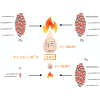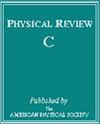Smallest drop of QGP: Thermodynamic properties ofp-Pbcollisions
IF 3.1
2区 物理与天体物理
Q1 Physics and Astronomy
引用次数: 0
Abstract
The extreme temperature and density conditions that arise in ultrarelativistic collisions of heavy nuclei enable the formation of the most fundamental fluid in the universe, the deconfined phase of quantum chromodynamics known as quark-gluon plasma. Despite the extensive experimental evidence gathered over the last decade for the production of quark-gluon plasma in colliding systems such as Au-Au and Pb-Pb, the formation of quark-gluon plasma in the collision of smaller systems such as -Pb remains an open question. In this study, we describe the evolution of matter formed in -Pb collisions at 5.02 TeV using a state-of-the-art hybrid model based on viscous relativistic hydrodynamics. We study the thermodynamic properties of the medium and the final state observables. Our results are compared with experimental data and first-principles lattice quantum chromodynamics calculations. The results support the formation of a collective phase of strongly interacting matter in high-multiplicity -Pb collisions.

最小的 QGP 液滴:p-Pbcollisions 的热力学特性
重原子核超相对论对撞中产生的极端温度和密度条件能够形成宇宙中最基本的流体,即量子色动力学中被称为夸克-胶子等离子体的去封闭相。尽管在过去十年中收集了大量实验证据,证明在金-金和铅-铅等对撞系统中产生了夸克-胶子等离子体,但在对铅等较小系统的对撞中形成夸克-胶子等离子体仍然是一个悬而未决的问题。在这项研究中,我们利用基于粘性相对论流体力学的最先进混合模型,描述了在 5.02 TeV 的 p-Pb 对撞中形成的物质的演化。我们研究了介质的热力学性质和终态观测值。我们将研究结果与实验数据和第一原理晶格量子色动力学计算结果进行了比较。结果支持在高倍率 p-Pb 对撞中形成强相互作用物质的集合相。
本文章由计算机程序翻译,如有差异,请以英文原文为准。
求助全文
约1分钟内获得全文
求助全文
来源期刊

Physical Review C
物理-物理:核物理
CiteScore
5.70
自引率
35.50%
发文量
0
审稿时长
1-2 weeks
期刊介绍:
Physical Review C (PRC) is a leading journal in theoretical and experimental nuclear physics, publishing more than two-thirds of the research literature in the field.
PRC covers experimental and theoretical results in all aspects of nuclear physics, including:
Nucleon-nucleon interaction, few-body systems
Nuclear structure
Nuclear reactions
Relativistic nuclear collisions
Hadronic physics and QCD
Electroweak interaction, symmetries
Nuclear astrophysics
 求助内容:
求助内容: 应助结果提醒方式:
应助结果提醒方式:


